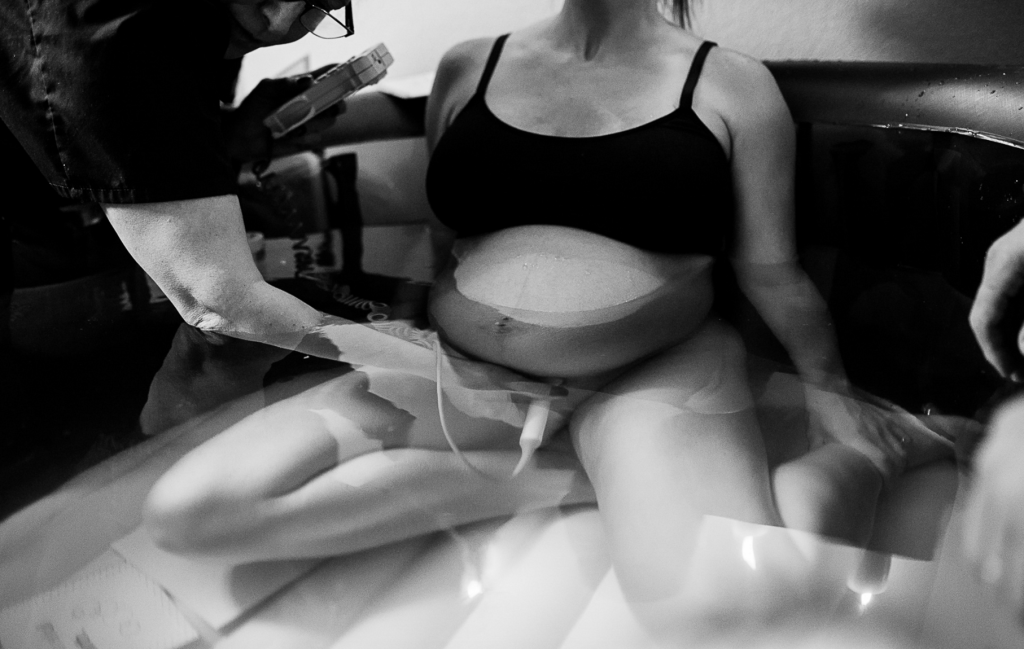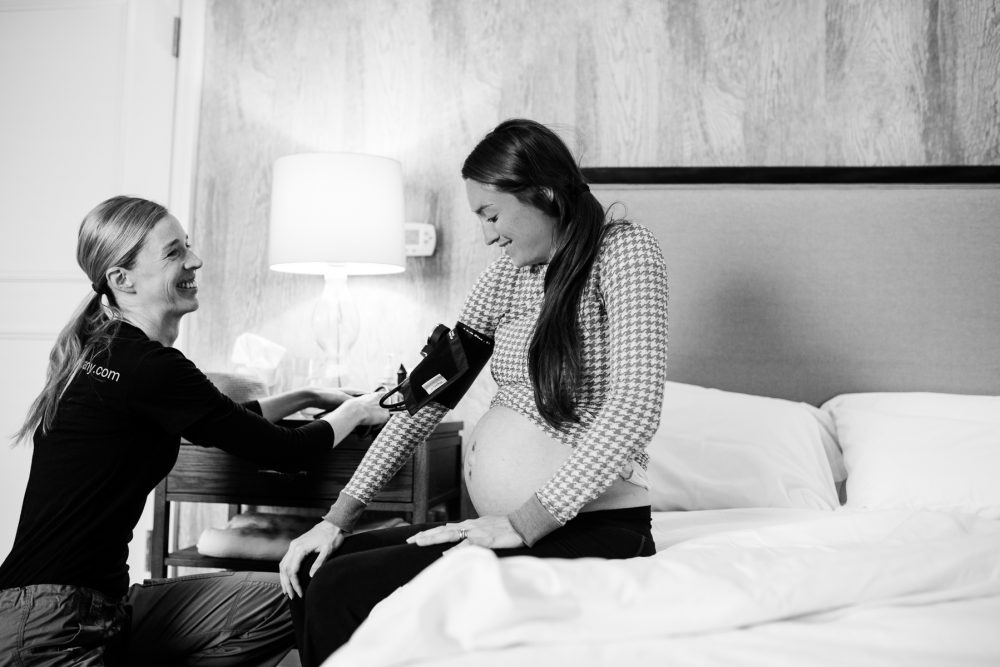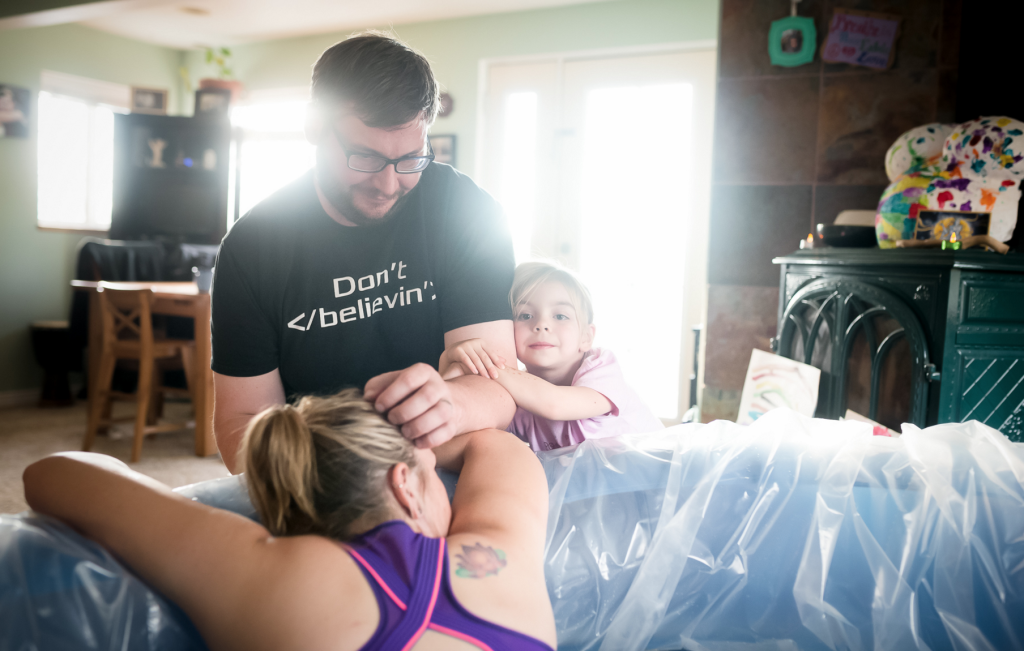As a masters trained certified nurse-midwife with a thriving homebirth midwifery practice for over 2 decades, I have worked both in and out of hospital settings. I am passionate about preserving the option of homebirth and promoting the homebirth midwifery model of care in all settings, including the operating room.
Homebirth as a Safe Option in Collaboration with Obstetrician Support
There is a pervasive belief in our modern day culture, that hospitals are the safest place to give birth, despite the extensive scientific research that planned home births with skilled midwives suggest otherwise. Many studies around the globe document the safety of planned home birth by professionally trained midwives, with outcomes at least as good, if not better than those in a hospital, especially when women have given birth vaginally before. The slight increased newborn mortality risk of home birth is estimated to be 1 in 1000. The absolute risk for each homebirth baby is actually quite small. Although the United States spends the most money on obstetric care, it ranks among the lowest among industrialized countries around the world in neonatal mortality and morbidity, and also ranks low in maternal mortality and morbidity.
Countries that demonstrate the best mother and baby outcomes have a high percentage of midwife-led maternity care for healthy women having normal pregnancies (which is the vast majority of pregnant women). They also have a larger percentage of homebirth midwifery care with supportive hospital/medical transfer when necessary, and obstetricians who provide care for women with higher risk complications and serious illnesses —just as they are educated to do as surgeons and medical physicians. When midwives and obstetricians work collaboratively as a team, both using their unique knowledge, training, skills and expertise, the mother and baby outcomes are far superior.

Midwives are educated in safeguarding the normalcy of pregnancy, birth and postpartum, not interfering with it when all is well, knowing when to monitor with sensitive and supportive care, and when and how to use holistic modalities, or medical intervention only when needed. They are also trained in preventing, assessing and treating complications, which most of the time can be handled simply and naturally, but sometimes do require consultation, collaboration with, or referral to an obstetrician. Although unpredictable occurrences and emergencies can occur in any birth setting, a low risk healthy pregnant woman entering many standard hospitals expecting a normal vaginal birth, is subjected to a routine cascade of procedures and interventions that significantly increase the risk of problems and complications. These may have potentially long-term negative physical and psychological consequences for mother and baby.
Be Aware of Perceived Risks of Birth in General
Focusing on the normal does not mean that problems go unrecognized or ignored; instead they are viewed as imbalances that need to be attended to. They are not expected or feared. That being said, certain risks do exist, in all birth settings, whether childbirth occurs in or out of the hospital; and there are risks unique to each place of birth. Some of these risks will never be eliminated no matter what our state of improved technology or medical progress. The safety of homebirth is well supported by the compilation of research, but childbirth is a pivotal threshold for baby and for mom. Some babies are born with abnormalities and injuries in spite of all the testing, technology, and expertise of the attendants.
Despite the fact that the relatively recent hospitalization of birth has failed to eradicate fetal or neonatal death, there is a cultural presumption that physicians and hospitals can guarantee a perfectly healthy mother and baby all of the time. This is a widespread myth. It not possible for any provider to guarantee anything. Birth defects may or may not be discernible by prenatal testing. The practice of nursing, midwifery, and medicine are not exact sciences, and no assurances can be made regarding the results of examinations, diagnostic tests, treatments, procedures, or interventions. It is impossible for any provider to provide full certainty of a normal healthy birth, mother or baby.

Advantages of a having a home birth
In addition to safety, there are many other advantages of homebirth midwifery care. It provides an alternative to the standard medical and hospital care that commonly occurs in the US—care that is perceived as impersonal, assembly line, high tech, fear-based, and oriented towards prevention of litigation.
Support team and comfortable environment
Other advantages include the healing power of human touch and presence, being surrounded by family or additional supportive people, security in giving birth in a familiar and comfortable environment of one’s home, feeling less inhibited in expressing unique responses to labor (such as freedom to eat and drink, vocalize, move, assume instinctual positions of comfort, express intimacy with a partner, breastfeed a toddler, practice individual cultural and faith based rituals to enhance coping). All of these can ease labor and birth.
No need for uncomfortable hospital transport
Another benefit includes not having to decide when to go to the hospital during labor. Going too early can slow progress and increase use of potentially risky interventions, while going too late can be extremely uncomfortable or even lead to a precarious unplanned birth en route.
Family Bonding at Home
Being able to choose how and when to include older siblings is another advantage to home birth. Siblings are making their own adjustments and can be challenged by an extended absence of their parents and excessive changes of the family routines. A home birth provides the opportunity for uninterrupted family bonding and nursing.
Cost Benefit of Homebirth to Families
Home births offer incredible cost savings for both insurance companies and those without insurance, and increased likelihood of having an empowering and deeply positive, beautiful, life-changing pregnancy and birth experience.
Getting holistic prenatal through postpartum care, and birthing in one’s own home attended by a well trained and skilled midwife, is a refuge for those who want to protect the normalcy and sanctity of childbearing.
The Midwifery Model of Care

My midwifery education and training enable me to provide prenatal, labor, delivery, postpartum and newborn care, as well as breastfeeding support for healthy low risk families. They may be planning to birth at home, in the birth center or hospital. I also provide gynecological and some primary care services to well women. I value a unique, comprehensive model of maternity care that provides an exceptional level of holistic support and services to achieve optimum health for mom and baby.
A Team of Pregnancy Support Professionals Encourage Overall Wellness
As a homebirth midwife, I address the wide range of ingredients that contribute to a profoundly positive and healthful pregnancy, birth and postpartum experience. These include: wholesome nutrition, healthy joyful living, personal education, connection with a supportive community, regular exercise and practice of yoga, meditation or other modalities to reduce internal stress and increase feelings of relaxation. I often draw on the expertise of additional professionals, from doulas and childbirth educators to lactation consultants, acupuncturists, massage therapists, chiropractors or osteopaths and other alternative health practitioners and specialists.
In an effort to bring back the needed village it takes to raise a new baby, and new parents, I also encourage each woman and her partner to take advantage of an array of classes and support groups. These include prenatal yoga, yoga for labor, postpartum mommy and me yoga classes, positive birth story pregnancy circles, community new mother blessing ceremonies, postpartum mom circles, pregnancy and new mom retreats, and a variety of other educational, supportive, and fun events, and ways to connect with other likeminded people and build community.
Personal Statistics, Practices, and Philosophies
Most women are candidates for homebirth midwifery care. In my individual practice, over 92% of pregnant women will have a home birth, and my cesarean section birth rate is less than 5% . This is comparable to most homebirth midwives, and much lower than the national average of 30% and rising. The great majority of hospital transfers in labor are non urgent—mostly first time vaginal birth mothers with stuck labors and exhaustion, after we have tried all possible modalities in the home setting.
My responsibilities include review of each woman’s complete health history, physical exam findings, and lab results to decide if she is eligible for continued homebirth midwifery care. I also provide ongoing evaluation and guidance throughout pregnancy, labor, birth and postpartum paying attention to signs of normalcy and/or signs of difficulties or problems. Situations are discussed openly, and there are no routine interventions unless medically needed and mutually agreed upon.
Individualized Care
Ongoing individualized care determines the needs of each childbearing family. I have created practice guidelines in conjunction with other homebirth midwives, evidence based research and the current midwifery literature. They reflect core philosophies and professional standards for practice, and they are reviewed and evaluated periodically as needed. These practice guidelines are developed and followed to protect the health and safety of each individual in my care.
I believe that pregnancy, birth, and postpartum are normal, natural bodily functions, like breathing; but they are also profoundly spiritual and inspiring, as well an empowering rite of passage for women and their families. I believe that childbearing families are best served by caregivers who encourage a kind, sensitive, respectful, lovingly supportive, family-centered environment, and maintain trust and calm confidence in the normalcy of the process, until proven otherwise. Safety, comfort and a deeply positive journey to motherhood are top priorities, and I take every reasonable precaution to ensure them. A safe and wonderfully satisfying childbirth experience requires the joint cooperative efforts of both the expectant family and health care providers, with a relationship based upon good open communication, mutual respect, and shared responsibility.

Education around birth
Education of women and their families is an integral part of my services, so that they are able to assume this responsibility for maintaining health and well-being, making informed decisions, planning and preparing for birth and postpartum, and actively participating in their health care throughout the process. The ideal outcome satisfies psychological, family and spiritual health beyond the obvious physical well-being. I believe that each person has the right to safe and satisfying health care by the provider of their choice, given with respect for individual preferences and cultural variations. I believe that normal, healthy women have the right to birth at home if they choose to do so, and as a licensed midwife, feel obliged to ensure that their experience is as safe and satisfying as possible for them. For the overwhelming majority of families, the experience of childbearing is one of health rather than illness, and there is a need for preventative and loving supportive care that is not only protected and free from harm, but also sensitive, compassionate and empowering.
Complications and making decisions
Although childbearing is a healthy, normal and natural process for most women and babies, problems can infrequently occur, and need to be noticed and attended to. Many complications can be prevented or dealt with simply at home, but some do require consultation with a collaborative physician or transfer to medical and hospital care to increase the likelihood of a healthy outcome. I support decisions regarding each woman’s care that are well informed and collaborative; however, rare emergencies may occur in which the professional judgment of the midwife and/or consulting physician must be relied on completely for the safety of mother and baby.
While I continue to grow in my academic, clinical and intuitive knowledge and wisdom, I am also expanding in understanding, appreciation and awe of the sanctity of life and its many facets, transitions and stages. I try as best as I can, within my human capacity, to give my utmost attention and care with integrity, honesty, and heartfelt commitment and dedication. I am forever appreciative for life saving hospital medical and surgical care when there are serious complications and illnesses. It is my hope that the homebirth midwifery model of care can be applied as much as possible in all birth settings, even if surgical birth is needed. It is my passion to do my part in improving and restoring humanity to maternity and newborn care.
This guest post was written by Anne Margolis CNM of www.homesweethomebirth.com. Connect with her on Instagram and Facebook.

Pingback:Homebirth Philosophy - A Family Art